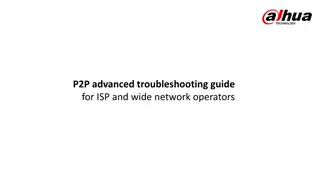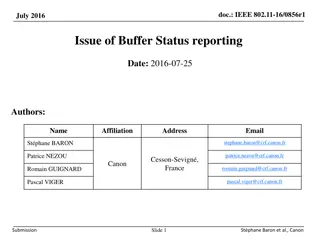Understanding Content Distribution Networks and P2P File Sharing in Advanced Computer Systems
Exploring the challenges of single-server setups, skewed web traffic popularity, web caching techniques like forward and reverse proxies, and the role of proxy caches in optimizing content delivery and reducing server costs.
Download Presentation

Please find below an Image/Link to download the presentation.
The content on the website is provided AS IS for your information and personal use only. It may not be sold, licensed, or shared on other websites without obtaining consent from the author. Download presentation by click this link. If you encounter any issues during the download, it is possible that the publisher has removed the file from their server.
E N D
Presentation Transcript
Content Distribution Networks + P2P File Sharing COS 518: Advanced Computer Systems Lecture 16 Mike Freedman
Single Server, Poor Performance Single server Single point of failure Easily overloaded Far from most clients Popular content Popular site Flash crowd Denial of Service attack 2
Skewed Popularity of Web Traffic Zipf or power-law distribution Characteristics of WWW Client-based Traces Carlos R. Cunha, Azer Bestavros, Mark E. Crovella, BU-CS-95-01 3
5 Proxy Caches origin server Proxy server client client 5
Forward Proxy Cache close to the client Under administrative control of client-side AS Proxy server client Explicit proxy Requires configuring browser client Implicit proxy Service provider deploys an on path proxy that intercepts and handles Web requests 6
Reverse Proxy origin server Cache close to server Either by proxy run by server or in third-party CDNs Proxy server Directing clients to the proxy Map the site name to the IP address of the proxy origin server 7
Google Design . . . Data Centers Servers Servers Router Router Private Backbone Reverse Proxy Reverse Proxy Internet Requests Client Client Client 8
Proxy Caches (A) Forward (B) Reverse (C) Both (D) Neither Reactively replicates popular content Reduces origin server costs Reduces client ISP costs Intelligent load balancing between origin servers Offload form submissions (POSTs) and user auth Content reassembly or transcoding on behalf of origin Smaller round-trip times to clients Maintain persistent connections to avoid TCP setup delay (handshake, slow start) 9
Limitations of Web Caching Much content is not cacheable Dynamic data: stock prices, scores, web cams CGI scripts: results depend on parameters Cookies: results may depend on passed data SSL: encrypted data is not cacheable Analytics: owner wants to measure hits Stale data Or, overhead of refreshing the cached data 11
Modern HTTP Video-on-Demand Download content manifest from origin server List of video segments belonging to video Each segment 1-2 seconds in length Client can know time offset associated with each Standard naming for different video resolutions and formats: e.g., 320dpi, 720dpi, 1040dpi, Client downloads video segment (at certain resolution) using standard HTTP request. HTTP request can be satisfied by cache: it s a static object Client observes download time vs. segment duration, increases/decreases resolution if appropriate 12
Peer-to-Peer Networks: BitTorrent BitTorrent history 2002: B. Cohen debuted BitTorrent Emphasis on efficient fetching, not searching Distribute same file to many peers Single publisher, many downloaders Preventing free-loading Incentives for peers to contribute 14
BitTorrent: Simultaneous Downloads Divide file into many chunks (e.g., 256 KB) Replicate different chunks on different peers Peers can trade chunks with other peers Peer can (hopefully) assemble the entire file Allows simultaneous downloading Retrieving different chunks from different peers And uploading chunks to peers Important for very large files 15
BitTorrent: Tracker Infrastructure node Keeps track of peers participating in the torrent Peers registers with the tracker when it arrives Tracker selects peers for downloading Returns a random set of peer IP addresses So the new peer knows who to contact for data Can have trackerless system Using distributed hash tables (DHTs) 16
BitTorrent: Overall Architecture Tracker Web Server C A Peer Peer [Seed] B [Leech] Downloader Peer US [Leech] 17
BitTorrent: Overall Architecture Tracker Web Server C A Peer Peer [Seed] B [Leech] Downloader Peer US [Leech] 18
BitTorrent: Overall Architecture Tracker Web Server C A Peer Peer [Seed] B [Leech] Downloader Peer US [Leech] 19
BitTorrent: Overall Architecture Tracker Web Server C A Peer Peer [Seed] B [Leech] Downloader Peer US [Leech] 20
BitTorrent: Overall Architecture Tracker Web Server C A Peer Peer [Seed] B [Leech] Downloader Peer US [Leech] 21
BitTorrent: Overall Architecture Tracker Web Server C A Peer Peer [Seed] B [Leech] Downloader Peer US [Leech] 22
BitTorrent: Overall Architecture Tracker Web Server C A Peer Peer [Seed] B [Leech] Downloader Peer US [Leech] 23
BitTorrent: Chunk Request Order Which chunks to request? Could download in order Like an HTTP client does Problem: many peers have the early chunks Peers have little to share with each other Limiting the scalability of the system Problem: eventually nobody has rare chunks E.g., the chunks need the end of the file Limiting the ability to complete a download Solutions: random selection and rarest first 24
BitTorrent: Rarest Chunk First Which chunks to request first? Chunk with fewest available copies (i.e., rarest chunk) Benefits to the peer Avoid starvation when some peers depart Benefits to the system Avoid starvation across all peers wanting a file Balance load by equalizing # of copies of chunks 25
Free-Riding in P2P Networks Vast majority of users are free-riders Most share no files and answer no queries Others limit # of connections or upload speed A few peers essentially act as servers A few individuals contributing to the public good Making them hubs that basically act as a server BitTorrent prevent free riding Allow the fastest peers to download from you Occasionally let some free loaders download 26
Bit-Torrent: Preventing Free-Riding Peer has limited upload bandwidth And must share it among multiple peers Tit-for-tat: favor neighbors uploading at highest rate Rewarding the top four neighbors Measure download bit rates from each neighbor Reciprocate by sending to the top four peers Optimistic unchoking Randomly try a new neighbor every 30 seconds So new neighbor has a chance to be a better partner 27
Conclusion Content distribution is hard Many, diverse, changing objects Clients distributed all over the world Reducing latency is king Contribution distribution solutions Reactive caching, proactive CDNs BitTorrent Distributed download of large files Anti-free-riding techniques Great example of how change can happen quickly in application-level protocols 28























